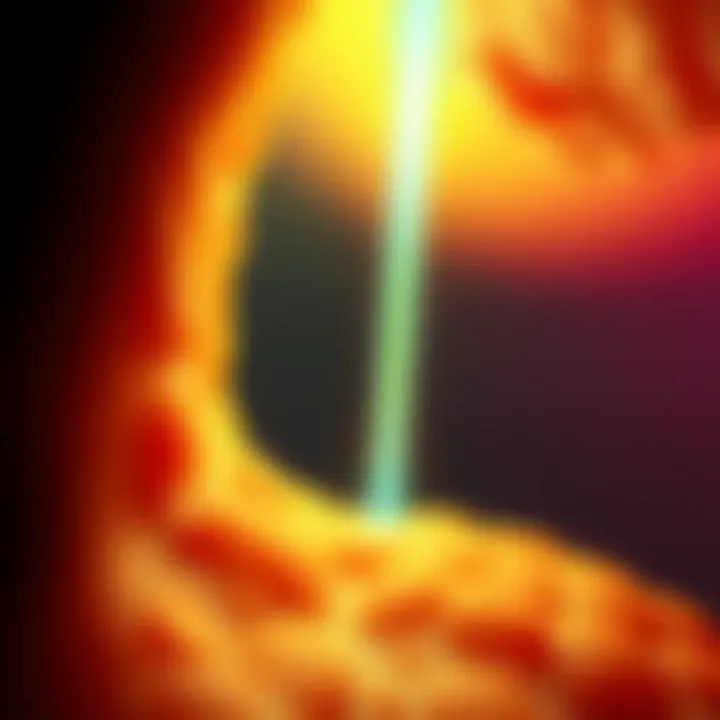Laser Light Therapy for Effective Arthritis Management


Intro
Arthritis is a condition that affects countless individuals worldwide, often leading to chronic pain, reduced mobility, and diminished quality of life. As such, finding effective management solutions is a priority for both patients and healthcare professionals. One of the intriguing possibilities on the table is laser light therapy, a non-invasive treatment that uses specific wavelengths of light to relieve pain and inflammation associated with arthritis.
In this exploration, we will consider the latest research on laser light therapy, its underlying principles, and practical applications in arthritis management. The aim is to provide a comprehensive look into this innovative approach and evaluate its potential role in modern therapeutic regimes.
Intro to Arthritis and Its Impact
Arthritis is not just a solitary disease; it's a complex tapestry of conditions that can deeply affect the quality of life for millions globally. As this article ventures into discussing laser light therapy as a potential treatment, understanding arthritis is pivotal. This knowledge sets the stage for appreciating how laser therapy may offer a glimmer of hope in arthritis management.
Understanding Arthritis
Arthritis encompasses more than just simple joint pain. It refers to inflammation of the joints that can manifest in various forms, such as osteoarthritis, rheumatoid arthritis, and psoriatic arthritis, each with distinct characteristics. Osteoarthritis, for instance, is often the result of wear and tear on the joints, leading to painful stiffness and decreased mobility. On the other hand, autoimmune forms like rheumatoid arthritis involve the body's immune system mistakenly attacking joint tissues, resulting in not only pain but potential destruction of joint integrity.
Fatigue, tenderness, and swelling are just a few symptoms that this condition brings, impacting daily endeavors from simple tasks like walking to more demanding activities.
Epidemiology and Prevalence
Arthritis is ubiquitous across demographics and geographies. Current statistics illuminate a staggering reality: approximately 54 million adults in the United States are affected by some form of arthritis. This number continues to grow, leading experts to project that nearly 78 million will be afflicted by 2040, creating a pressing need for effective treatment modalities.
The prevalence of arthritis shows notable variations based on age, sex, and even ethnicity. For instance, the condition is more common among older adults, with women being disproportionately affected compared to men. Such patterns highlight the necessity of tailoring treatments to diverse populations, ensuring that effective interventions are accessible to those in need.
Traditional Treatment Options
Traditional management strategies focus mainly on alleviating pain and improving joint function. They typically include a mix of medications, physical therapy, and lifestyle modifications. Commonly prescribed drugs, such as nonsteroidal anti-inflammatory drugs (NSAIDs) like ibuprofen, aim to reduce pain and inflammation. In more severe cases, disease-modifying antirheumatic drugs (DMARDs) are recommended to slow the progress of autoimmune types of arthritis.
Though these traditional approaches play a crucial role in managing symptoms, they often come with side effects and will not address the underlying mechanisms of arthritis. As such, healthcare providers continuously seek alternative methods like laser light therapy, hoping to expand the arsenal of weapons against this formidable adversary.
Principles of Laser Light Therapy
Understanding the principles behind laser light therapy is crucial for grasping its potential role in managing arthritis. In essence, laser light therapy harnesses certain wavelengths of light to stimulate biological processes in tissues and cells. This method diverges from traditional treatments by leveraging light to encourage healing, as opposed to relying solely on pharmacological solutions or more invasive procedures.
Mechanisms of Action
Laser light therapy functions through a straightforward but effective mechanism. The energy from the light is absorbed by the cells, prompting biochemical reactions that lead to increased ATP production, which is fundamental for cellular energy. This energization promotes faster tissue repair and can reduce inflammation.
Moreover, the application of laser therapy enhances blood circulation, which subsequently delivers vital oxygen and nutrients to affected joints and areas suffering from arthritis. This multi-faceted approach not only relieves pain but also addresses inflammation at its root, making it a promising alternative or complementary approach to traditional therapies.
Types of Laser Technologies
When diving into laser light therapy, one must consider the various technologies at play. Each type of laser offers distinct advantages that can cater to different patient needs.
Low-Level Laser Therapy
Low-Level Laser Therapy (LLLT) is known for its non-invasive nature and safety profile, making it appealing for many seeking relief from arthritis symptoms. One standout characteristic of LLLT is its capability to penetrate tissues at shallow depths, which is often enough to foster recovery in areas facing inflammation and pain. This method is particularly good for surface-level injuries or conditions where deeper penetration isn’t necessary.


A unique feature of LLLT is its low thermal effect, which means it provides relief without causing any significant heat or discomfort, appealing to patients who might be sensitive to pain. However, the downside may include longer treatment times as the effects build gradually, necessitating consistent sessions to see optimal results.
Class Laser Therapy
On the opposite side of the spectrum, Class IV Laser Therapy offers a more powerful approach to light therapy treatment. This type typically produces higher energy levels that allow it to penetrate deeper tissues. Such characteristics make it well-suited for treating more significant arthritic conditions or chronic pain that affects larger areas of the body since it can deliver more concentrated light energy effectively.
One significant advantage of Class IV is its ability to produce quicker pain relief, often within fewer sessions compared to LLLT. However, its higher energy output can potentially lead to increased warmth in the treated areas, which could pose a risk for some patients, necessitating careful monitoring during application.
Infrared Laser Systems
Infrared Laser Systems represent another innovative approach to laser therapy, particularly notable for their ability to target tissues at varying depths. The infrared wavelengths are particularly effective in stimulating cellular activities deeper within the tissue. This can translate into enhanced outcomes for joints that are compromised due to arthritis.
The key characteristic that sets infrared lasers apart is their efficacy in both pain relief and inflammation reduction at deeper tissue levels. They also help in cell regeneration and tissue repair processes. However, the disadvantages include the complexity of the equipment and the necessity for trained professionals to ensure proper application and safety.
Ending
The principles behind laser light therapy illustrate its potential as a sophisticated and multifaceted approach to arthritis management. As laser technologies evolve, their application in clinical settings will likely enhance patient outcomes, offering both practitioners and patients additional options in their approach to pain management and tissue recovery.
Clinical Evidence for Laser Light Therapy
The role of clinical evidence in supporting the use of laser light therapy for treating arthritis cannot be understated. It provides a foundation for assessing how effective this technology is in tackling the persistent pain and mobility issues associated with the condition. Relevant studies contribute critical insights into efficacy, safety, and the overall therapeutic experience patients encounter, guiding both practitioners and patients towards informed treatment decisions.
Efficacy in Pain Management
A significant parameter when analyzing laser light therapy is its efficacy in pain management. Research showcases that laser therapies, particularly Low-Level Laser Therapy (LLLT), can reduce pain levels in individuals suffering from arthritis. In a double-blind, placebo-controlled trial involving older adults with knee osteoarthritis, patients receiving LLLT reported a marked decrease in pain compared to those given a sham treatment. This aligns with various studies indicating that photo-biomodulation, the process by which laser light interacts with cellular mechanisms, can stimulate pain-reducing effects at the local tissue level.
Moreover, patients often express satisfaction with the therapy, noting a more significant relief effect and less reliance on conventional pain medications like nonsteroidal anti-inflammatory drugs (NSAIDs). The implication here is not only centered on immediate pain reduction but also on minimizing potential side effects from commonly prescribed medications.
Improvement in Joint Function
Laser light therapy also showcases potential in enhancing joint function. The technology works by promoting tissue repair and reducing inflammation. In clinical scenarios, several studies have documented improvements in range of motion among patients undergoing laser treatments for arthritis. For instance, participants in one study demonstrated a 30% increase in mobility within weeks of commencing therapy, a game-changer for individuals who have long struggled with stiff joints.
The impact on joint function is not solely limited to subjective feelings. Objective measures, including increased ability to perform daily activities and reduced stiffness, add a valuable layer to understanding how laser therapy might pad the standard arthritis treatment regimen. As joint function improves, so does the overall quality of life for patients, emphasizing the therapy's role as a viable option worth considering.
Long-Term Outcomes
When it comes to evaluating the long-term outcomes of laser light therapy, ongoing studies suggest that the benefits can extend beyond initial treatment cycles. Some investigations indicate that consistent use of laser therapy may yield sustained improvements in both pain management and joint function. A cohort study tracking patients over two years found that those who participated in scheduled laser sessions not only enjoyed continued pain relief but also reported an enhanced ability to engage in physical activities like walking or light exercise.
Though the long-term benefits are promising, it's crucial to approach these findings with a degree of caution. The variations in treatment protocols, patient demographics, and disease severity can influence outcomes. As research continues to evolve, further investigations will be necessary to establish standardized guidelines for incorporating laser light therapy into routine arthritis management effectively.
In summary, the efficacy, improvement in joint function, and potential long-term benefits of laser light therapy represent an essential area of interest in arthritis management and warrant further exploration to optimize treatment strategies.
Understanding and integrating these clinical insights can assist patients and healthcare providers in making more informed choices that may lead to improved health outcomes.
Comparison with Other Modalities
When delving into the realm of arthritis management, it's paramount to consider the efficacy of laser light therapy in relation to other available treatment options. Understanding how different modalities stack up against each other is crucial for patients and healthcare providers alike. This section meticulously examines three primary alternatives: physical therapy, pharmacologic interventions, and surgical options. Integrating these perspectives offers a broader understanding of how laser therapy can fit into personalized treatment plans.


Physical Therapy
Physical therapy plays a significant role in arthritis management, often serving as the first line of defense. A qualified physical therapist develops a tailored rehabilitation plan focusing on the patient’s specific needs. Techniques from hydrotherapy to strengthening exercises are employed, enhancing mobility and significantly reducing pain. The hands-on approach gives individuals the chance to gain a better understanding of their bodies, promoting self-management and independence.
- Benefits: This personalized engagement can improve joint function, which is vital for long-term wellbeing. Many patients find that tailored exercises provided by a knowledgeable therapist not only alleviate immediate pain but also bolster their ability to engage in daily activities.
- Considerations: However, physical therapy requires consistent attendance and participation. For individuals with severe pain, even simple movements can be daunting, which might hinder progress.
In contrast, laser light therapy offers a non-invasive, often more tolerable treatment modality. This method can complement physical therapy by preparing the joint tissues for exercise, effectively maximizing its benefits.
Pharmacologic Interventions
Pharmacologic interventions, including over-the-counter analgesics and prescription medications, are commonly prescribed to manage arthritis symptoms. Nonsteroidal anti-inflammatory drugs (NSAIDs) like ibuprofen or more potent drugs such as corticosteroids are often the go-to options for pain relief.
- Short-Term Relief: These medications can provide quick relief from acute pain episodes, helping patients regain some level of functionality.
- Long-Term Concerns: However, they come with potential side effects and even dependency risks, especially when used in the long-term. Issues such as gastrointestinal distress or liver dysfunction can arise, prompting healthcare providers to seek safer alternatives.
Compared to laser light therapy, the latter presents fewer systemic risks, focusing directly on the affected area, often producing pain relief without the side effects associated with pharmaceuticals.
Surgical Options
When conservative treatments fail to yield substantial results, surgical options may be considered. Procedures can range from arthroscopy to joint replacement. While surgeries can drastically improve the quality of life for those severely impacted by arthritis, they also come with inherent risks, including surgical complications or prolonged recovery times.
- Benefits of Surgery: For some, surgical interventions can restore a sense of normalcy, allowing patients to return to activities they may have thought lost for good.
- Considerations: On the flip side, the decision to undergo surgery is significant, often compounded by lengthy waiting lists and follow-up rehabilitation sessions.
In juxtaposition, laser light therapy can provide immediate relief and is less invasive. It eliminates the hassles associated with surgical procedures, enabling patients to manage their conditions proactively, potentially delaying or even avoiding the need for surgery altogether.
Overall, assessing the landscape of arthritis treatments reveals that each modality has its unique merits and drawbacks. While laser light therapy stands out for its non-invasive nature, combining it with other treatments might indeed provide the most effective approach to managing this complex condition.
For more information on arthritis and potential treatment methods, consider visiting resources like CDC Arthritis or NIH Medline.
Deciding on the right treatment path ought to involve thorough discussions with healthcare providers. Understanding individual circumstances, expectations, and the realities of each treatment option could very well lead to more favorable outcomes.
Safety and Side Effects of Laser Therapy
When considering any treatment modality for arthritis, it is crucial to weigh the safety and potential side effects. Laser light therapy, though marketed as a non-invasive option, is not without its risks. Understanding these aspects can help patients and healthcare providers make informed decisions about incorporating this therapy into their management protocols.
The significance of examining the safety of laser light therapy stems from the need to ensure that the benefits outweigh any risks involved. For those suffering from chronic arthritis, the lure of a new treatment can be enticing, but one must ask: how does this therapy affect my health in the long run? Identifying common side effects and contraindications is essential for assessing whether laser therapy is appropriate for an individual's unique health circumstance.
Common Side Effects
While laser light therapy is generally considered safe, patients may experience some side effects. These effects are often mild and transient, but awareness is crucial. Below are several commonly reported side effects:
- Localized Skin Irritation: Patients may notice redness or a burning sensation in the area treated. This is usually brief and resolves quickly after treatment.
- Pain or Discomfort: Some individuals report mild discomfort during or after the procedure, akin to the sensation felt during a typical physical therapy session.
- Temporary Swelling: In some cases, the area treated can become slightly swollen, which typically subsides shortly after the session.
- Photosensitivity: After treatment, some patients may experience heightened sensitivity to light, making it uncomfortable to be outdoors without protection.
It’s important for patients to discuss these potential side effects with their healthcare providers beforehand to ensure that their expectations align with their treatment experience.
Contraindications


Though laser therapy can provide substantial relief for many, it’s not suitable for everyone. Understanding contraindications is vital for safe application. Here are some key considerations that can exclude a patient from receiving laser light therapy:
- Active Cancer: Patients with history or current diagnosis of cancer should avoid laser therapy as it may stimulate tumor growth.
- Pregnancy: The safety of laser therapy during pregnancy hasn’t been fully established, thus pregnant women are usually advised against it.
- Severe Diabetes: Individuals with uncontrolled diabetes should approach laser therapy cautiously as healing responses may be impaired.
- History of Photosensitivity: For those who previously experienced adverse reactions to light therapies, it is prudent to avoid laser treatment.
- Recent Surgery at the Treatment Site: If a patient has had recent surgery, laser application may hinder proper healing and should be avoided in immediate post-operative phases.
It's crucial to consult a healthcare professional to determine whether laser light therapy is suitable, especially if any of the above conditions apply.
In summary, while laser light therapy offers promising avenues for arthritis management, it is essential to keep safety and side effects at the forefront of discussions. Patients should be made aware of common side effects and contraindications to ensure a safe and effective treatment process. This understanding not only fosters trust between patients and providers but also encourages informed decision-making tailored to individual health needs.
For more detailed insights into laser therapy and its implications, consider exploring resources such as Wikipedia or medical databases available on Gov and Edu.
Future Directions in Research
The field of laser light therapy is at a pivotal point, especially when it comes to its effectiveness in managing arthritis. Beyond existing knowledge, exploring future directions can unveil significant avenues for both patients and practitioners. This exploration isn't just about enhancing treatment efficacy; it also encompasses the desire to provide more holistic, integrated care options for those suffering from arthritis, which is essential as the patient demographic evolves.
Innovative Techniques in Laser Therapy
Innovative techniques represent the cutting edge of laser therapy research. As technology evolves, so does the potential to refine laser application methods. One promising approach is the development of multi-wavelength lasers, which can target various tissue depths and conditions simultaneously. By adjusting the wavelengths, practitioners may achieve better penetration through layers of skin and tissue, allowing for targeted treatment strategies that can minimize pain and accelerate healing.
Another exciting innovation is combining laser therapy with real-time imaging technology. This fusion can help clinicians visualize how laser light interacts with tissues during the treatment. Employing techniques like ultrasound or MRI in conjunction with laser therapy could potentially allow practitioners to optimize treatment parameters on-the-fly. Such advancements not only promise to enhance effectiveness but also to minimize risks associated with improper laser application.
Additionally, research into automated systems for laser delivery is gaining traction. These systems could standardize treatment protocols, reduce human error, and enhance the consistency of patient outcomes. Integrating Artificial Intelligence into treatment plans may enable personalized therapy schedules, based on patient recovery patterns and feedback.
Integration with Regenerative Medicine
Integrating laser light therapy with regenerative medicine is another critical direction for future research. Regenerative medicine aims to repair or replace damaged tissues, and combining it with laser therapy can maximize treatment results. For instance, studies have indicated that low-level laser therapy can enhance the proliferation of stem cells and facilitate tissue regeneration. This interplay could lead to innovative protocols that not only relieve pain but also actively promote healing within joints, potentially altering the course of arthritis treatment.
The relationship between laser therapy and platelet-rich plasma (PRP) therapy also warrants attention. PRP involves drawing a patient’s blood, processing it, and injecting the concentrated platelets back into affected joints to promote healing. When paired with laser therapy, this combo might amplify the effectiveness of PRP injections, leading to improved patient outcomes.
Moreover, there's growing interest in exploring the impact of laser therapy on reducing inflammation and accelerating recovery post-surgery. As some surgical interventions lead to significant downtime, the use of laser therapy could accelerate healing timelines, enabling patients to return to their daily lives sooner.
In summary, the future of laser light therapy for arthritis management is ripe with potential innovations. Embracing novel techniques and synergistic approaches may redefine patient experiences in managing arthritis, ultimately leading to more effective and comprehensive care.
By focusing on these future research directions, healthcare professionals can pave the way for laser light therapy to become an essential component of arthritis care protocols. As more studies validate these technological advancements, the community can look forward to more effective, personalized, and integrative approaches to managing arthritis.
Epilogue
The conclusion serves as a pivotal recap of the role laser light therapy may play in managing arthritis. Throughout this article, we've navigated through intricate details about arthritis, its treatments, and how laser technology intertwines with these factors. This summary not only reiterates key findings but also sets the stage for informed discussions among clinicians and patients alike.
Summary of Findings
The exploration of laser light therapy highlights several significant points. Notably:
- Mechanisms of Action: Laser light therapy works by stimulating cellular function, which is essential in healing tissues, reducing inflammation, and alleviating pain.
- Efficacy in Clinical Settings: Evidence from numerous studies suggests that patients experience marked improvements in pain management and joint function post-treatment.
- Long-Term Benefits: The ongoing use of laser therapy has been associated with positive long-term outcomes, such as sustained pain relief and enhanced mobility.
- Safety Profile: Laser treatment has a lower side effect profile compared to traditional pharmaceutical approaches, making it a feasible option for many patients.
In brief, the compelling evidence substantively grounds laser therapy as a viable addition to conventional arthritis treatments.
Recommendations for Patients and Clinicians
For those considering or currently employing laser light therapy, several recommendations may enhance its effectiveness and safety:
- Consult with a Specialist: Before diving into treatment, it's crucial to have a robust conversation with a healthcare provider who understands both laser therapy and the specifics of the patient's arthritis condition.
- Understand the Options: There are various types of laser systems available; familiarizing oneself with the distinctions between low-level laser therapy and class IV laser therapy can guide better treatment choices.
- Monitor Progress: Regular follow-ups and assessments can help ensure that the treatment is yielding the desired results. Keeping a pain journal might be helpful for tracking improvements over time.
- Be Aware of Contraindications: Patients must be informed about situations where laser therapy may not be appropriate, such as certain skin conditions or infections.
By merging knowledge and personal experience, patients and clinicians can collaboratively develop a treatment plan that maximizes the benefits of laser light therapy while mitigating potential risks. This nuanced approach fortifies a path towards more effective arthritis management.







